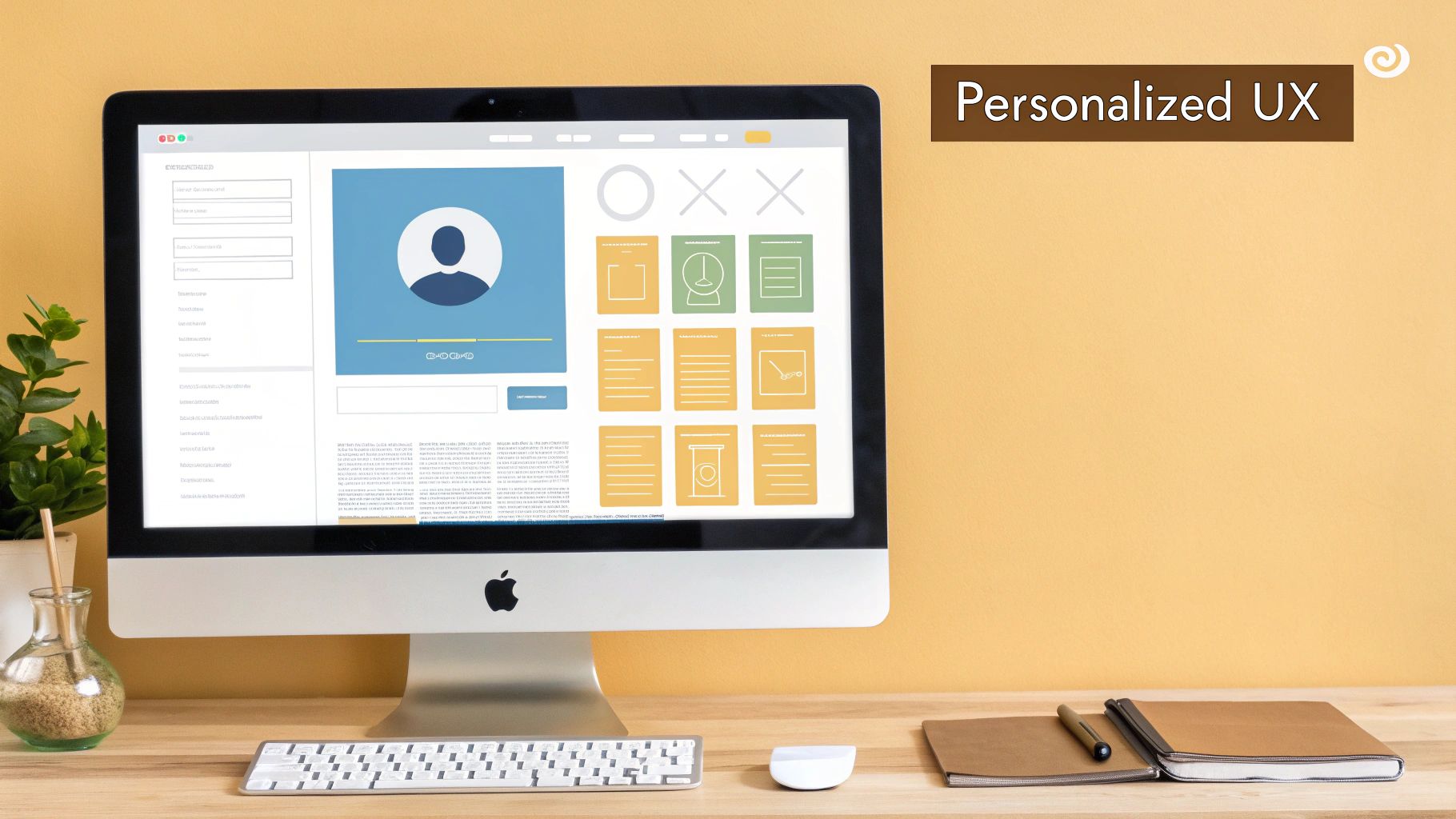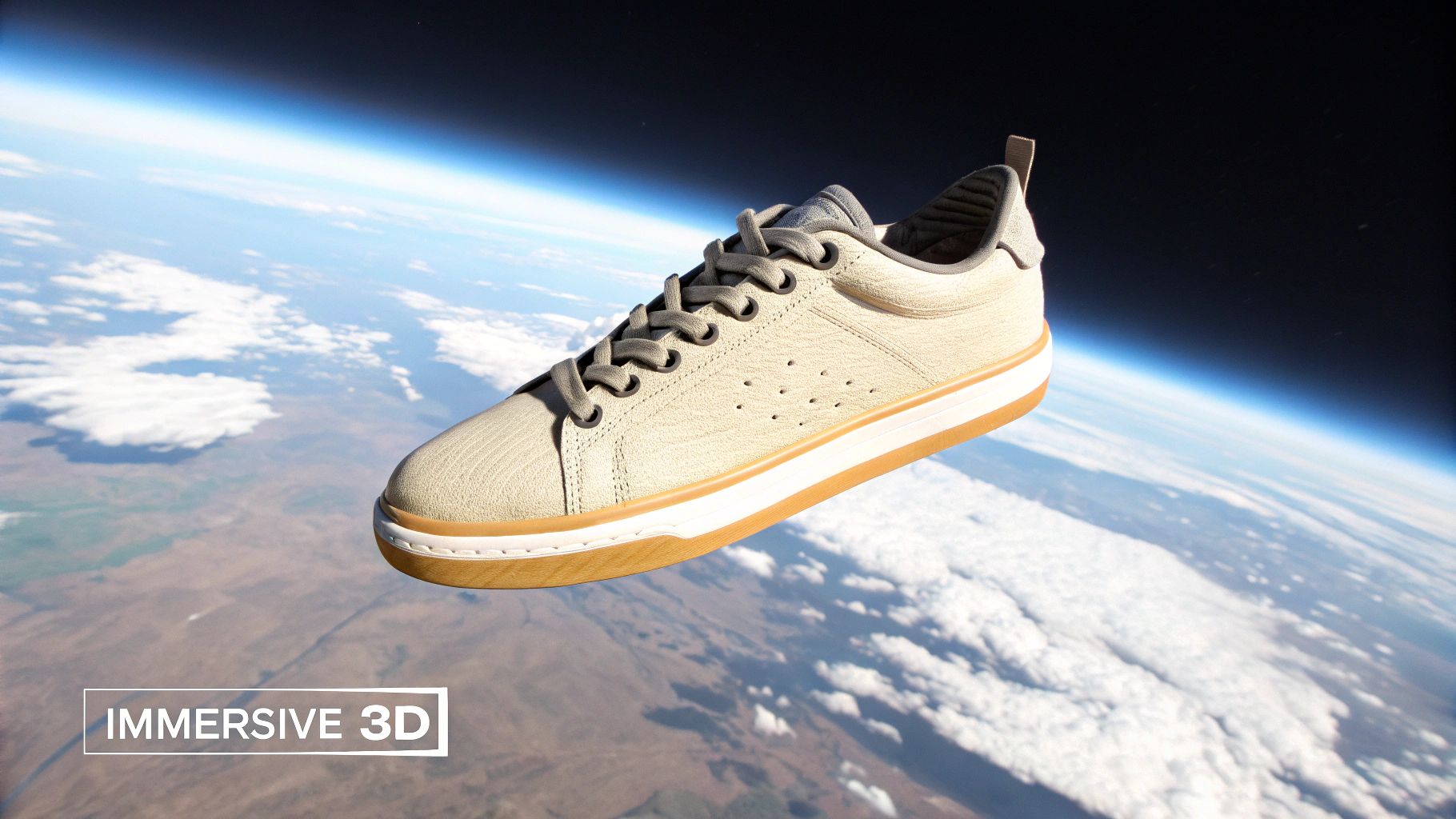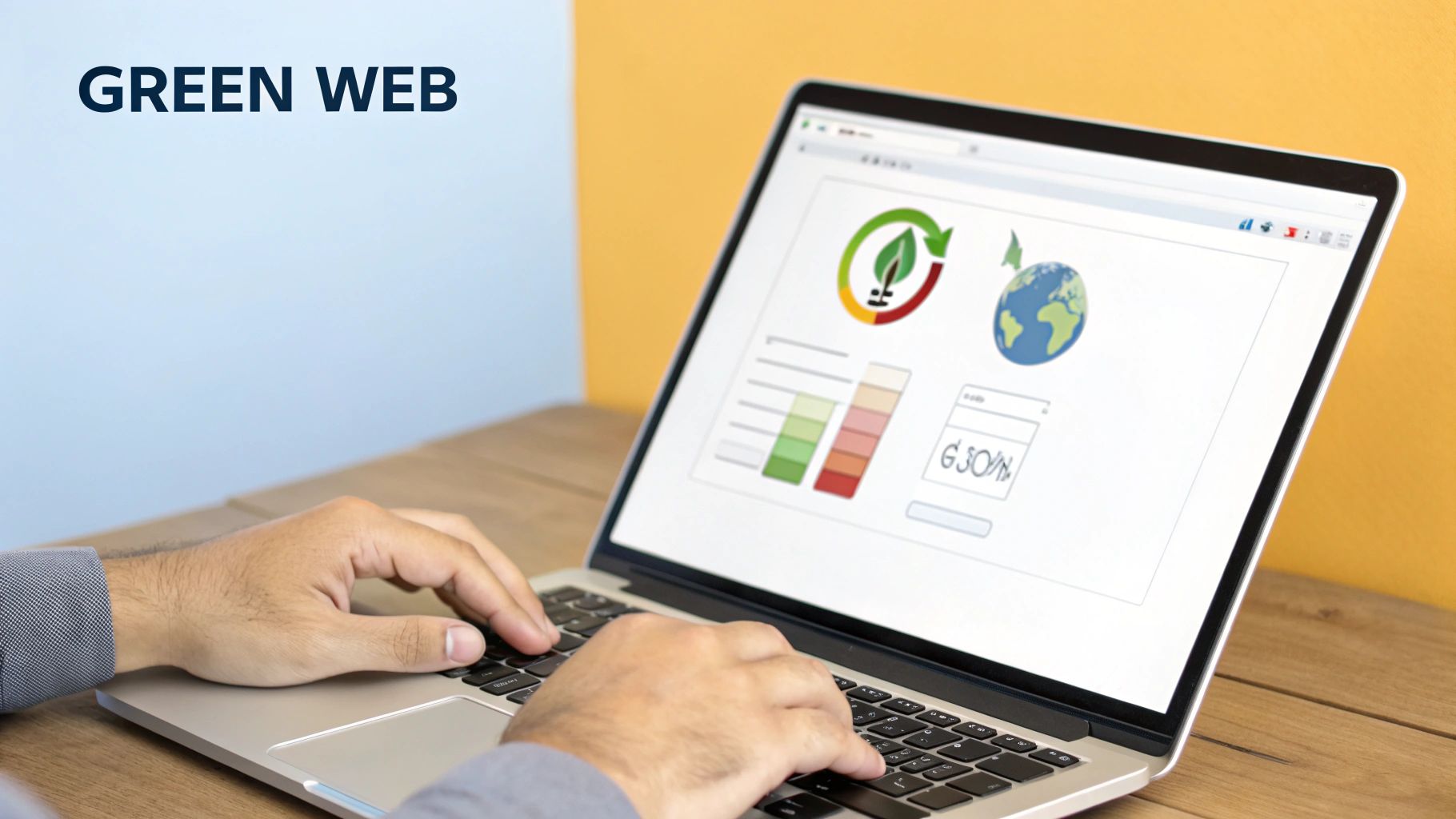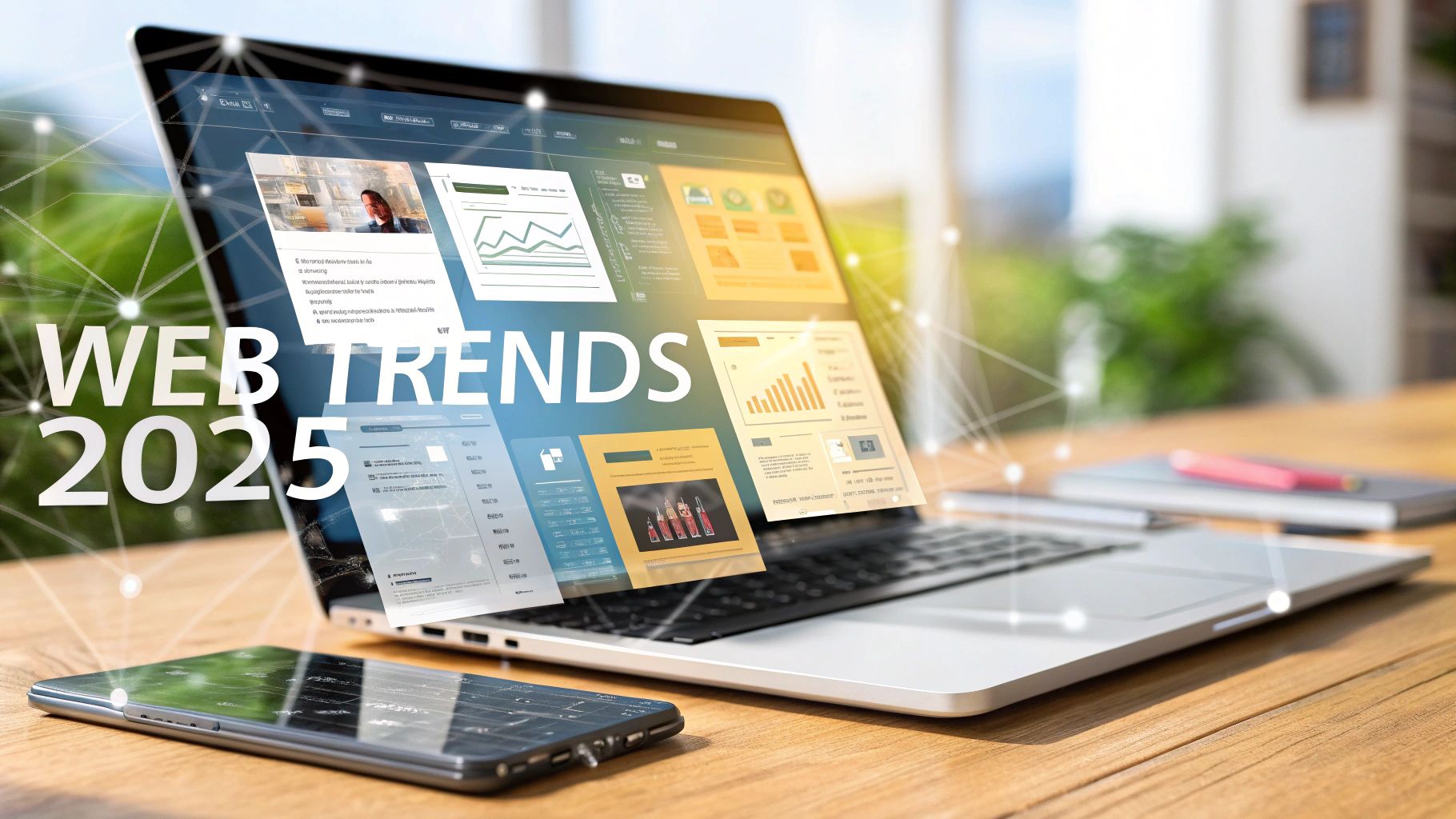As the digital world advances, staying ahead of the curve is no longer an option, it's a necessity. The web design trends of 2025 are moving far beyond mere aesthetics, focusing instead on creating more intelligent, immersive, and ethically conscious user experiences. This shift marks a significant change in how businesses in Omaha and beyond must approach their digital strategy, from e-commerce platforms to local service providers.
From AI that anticipates user needs before they arise, to sustainable design practices that reduce our collective digital footprint, this year’s most important innovations are set to fundamentally redefine user engagement and interaction. Whether you're a business owner planning a site redesign, an e-commerce retailer aiming to boost conversions, or a developer seeking to innovate, understanding these shifts is critical for success.
This guide is designed to be your definitive resource, breaking down the 10 most impactful trends you need to know for the coming year. We'll move past the surface-level talk and provide specific, actionable insights to help you build a website that not only looks modern but also performs exceptionally. Let’s explore the future of web design and prepare your platform for what comes next.
1. AI-Powered Personalized User Experiences
The era of one-size-fits-all websites is officially over. As we move into 2025, one of the most transformative web design trends involves leveraging artificial intelligence to create deeply personalized user experiences. This goes far beyond simply addressing a user by their first name; it's about dynamically adapting a website’s content, layout, and functionality based on individual user behavior, preferences, and real-time interactions.

Imagine a site where the user interface (UI) subtly reorders itself to prioritize features a specific user frequently accesses or an e-commerce platform that adjusts product showcases based on a visitor's browsing history and purchase patterns. Giants like Netflix, which alters homepage art to appeal to individual viewing habits, and Amazon, with its powerful recommendation engine, have already proven the immense value of this hyper-personalized approach. This trend is no longer exclusive to tech titans; it's becoming an accessible and crucial strategy for businesses of all sizes.
How to Implement AI Personalization
To get started without a massive initial investment, focus on incremental integration.
- Start Small: Begin by tracking simple user behaviors, such as click patterns or time spent on certain pages, to inform basic content recommendations.
- Ensure Transparency: Clearly communicate your data usage policies in your privacy statement. Users are more receptive to personalization when they understand how their data is being used to enhance their experience.
- Maintain a Baseline: Always provide a standard, non-personalized version of your site as a fallback. This ensures accessibility and caters to users who may have privacy concerns or are visiting for the first time.
By creating a more relevant and intuitive digital environment, you can significantly boost engagement, conversions, and customer loyalty. To delve deeper into the fundamentals that power these advanced strategies, explore these user experience design best practices for a solid foundation.
2. Immersive 3D and WebGL Experiences
The flat, two-dimensional web is giving way to a more dynamic and interactive digital space. A key driver of this evolution, and one of the most exciting web design trends 2025 has to offer, is the widespread adoption of immersive 3D experiences powered by WebGL. This browser-based technology allows for desktop-app-quality graphics and animations, transforming static websites into captivating digital environments.

This trend moves beyond simple visual flair; it's about creating functional, engaging interactions that were previously impossible on the web. Think of Apple's product pages, where you can inspect a new iPhone from every angle, or Nike's interactive shoe customizers that provide a tangible sense of the final product. These experiences use 3D models and realistic physics to allow users to explore, configure, and connect with products in a profoundly new way, blurring the line between digital browsing and physical interaction.
How to Implement Immersive 3D
Integrating 3D doesn't require rebuilding your site from scratch. You can start by enhancing key user touchpoints.
- Optimize 3D Assets: Keep file sizes small to ensure fast loading times. Use progressive loading, where the model's quality improves as more data is downloaded, to keep users engaged.
- Provide 2D Fallbacks: Not all devices or browsers can handle complex 3D rendering. Offer a standard 2D version of the experience to ensure accessibility and a consistent user journey for everyone.
- Test Extensively: Cross-browser and cross-device compatibility is crucial. Test your 3D experience on a wide range of hardware, from high-end desktops to older mobile phones, to identify and fix performance issues.
By incorporating interactive 3D elements, businesses can create memorable, high-impact experiences that differentiate their brand and significantly increase user engagement and conversion rates. For those looking to explore how to apply these advanced concepts, understanding the principles of custom web application development can provide valuable insights into building robust and scalable interactive platforms.
3. Advanced Micro-Interactions and Motion Design
In 2025, the subtlety of motion is becoming a primary language of web design. Advanced micro-interactions and purposeful motion design are no longer just decorative flair; they are essential web design trends for creating intuitive, responsive, and engaging interfaces. These are the small, animated responses that occur when a user interacts with a site, such as a button that subtly changes shape when clicked or an icon that animates to confirm an action. They provide immediate feedback, guide attention, and make the digital experience feel more tangible and alive.

This trend elevates usability by communicating system status, preventing errors, and creating a satisfying, emotional connection. Think of Stripe's smooth payment form animations that guide you seamlessly through checkout, or the gentle bounce of a Slack message confirming it has been sent. These details, inspired by foundational principles from Disney and refined by platforms like Apple and Google's Material Design, transform a static page into a dynamic conversation between the user and the interface. By making interactions feel natural and rewarding, businesses can significantly improve user satisfaction and perceived performance.
How to Implement Advanced Motion Design
Integrating meaningful motion requires precision and a focus on function over flash.
- Prioritize Functionality: Every animation should have a purpose, such as clarifying a state change or guiding the user’s focus. Avoid purely decorative motion that can distract or slow down the experience.
- Keep it Brief: For micro-interactions, aim for animation durations under 300 milliseconds. This ensures the interface feels snappy and responsive, not sluggish.
- Respect User Preferences: Always implement support for the
prefers-reduced-motionmedia query to provide a simplified experience for users who are sensitive to animation.
By focusing on purposeful animation, you can create a more polished, professional, and user-friendly website that leaves a lasting positive impression.
4. Voice User Interface (VUI) Integration
The rise of smart speakers and voice assistants has fundamentally changed how we interact with technology, and this trend is rapidly moving into web design. In 2025, one of the key web design trends will be the integration of Voice User Interfaces (VUI), allowing users to navigate sites, perform searches, and complete actions using natural speech. This creates a more accessible, hands-free, and conversational browsing experience.

This shift from clicks to commands bridges the gap between traditional interfaces and conversational AI. Pioneers like Domino's, with its voice-enabled pizza ordering, and financial institutions like Capital One, offering voice banking features, demonstrate the practical power of VUI. By enabling voice commands, you cater to users who are multitasking, have motor impairments, or simply prefer speaking over typing. This technology, powered by advancements like the Web Speech API, is no longer a novelty but a strategic advantage for creating inclusive and efficient digital platforms.
How to Implement VUI Integration
Integrating VUI requires a focus on clarity, privacy, and reliability to ensure a seamless user experience.
- Provide Clear Instructions: Guide users with on-screen prompts or examples of acceptable voice commands to minimize confusion and frustration.
- Offer Visual Feedback: Visually confirm that a voice command has been received and is being processed. This could be a simple animation or a text transcript of the command.
- Ensure Graceful Fallbacks: Always provide traditional input methods like keyboards and mice. VUI should be an enhancement, not a replacement, ensuring the site remains fully functional for all users.
By thoughtfully adding voice capabilities, you can make your website more accessible and convenient, setting a new standard for user interaction and engagement. To learn more about the technical foundations, consider exploring the resources available from the W3C on the Web Speech API.
5. Sustainable and Green Web Design
As digital consumption grows, so does its environmental impact. In 2025, one of the most responsible and forward-thinking web design trends is the move toward sustainable, or green, web design. This approach prioritizes energy efficiency and minimal resource consumption to reduce the carbon footprint of websites and digital services. It’s about creating fast, accessible, and user-friendly experiences that are also kind to the planet.
This trend is about more than just ethics; it’s about performance. Efficiently coded, lightweight websites load faster, perform better on low-bandwidth connections, and offer an improved user experience, which directly correlates with higher engagement and better SEO rankings. Pioneers like Wholegrain Digital with its low-carbon websites and Patagonia with its purpose-driven, efficient design demonstrate that sustainability and high performance go hand in hand. This mindful approach builds brand trust and resonates with environmentally conscious consumers.
How to Implement Green Web Design
Adopting sustainable practices is an incremental process that enhances both environmental responsibility and site performance.
- Audit Your Footprint: Use tools like the Website Carbon Calculator to measure your site's current energy consumption and identify areas for improvement.
- Optimize Assets: Implement lazy loading for images and videos, compress media files without sacrificing quality, and choose modern, efficient formats like WebP.
- Choose Green Hosting: Partner with a web hosting provider that is transparent about its commitment to using renewable energy sources to power its data centers.
- Streamline Your Code: Minimize the use of third-party plugins, optimize database queries, and use system fonts where possible to reduce HTTP requests and data transfer.
By building with efficiency in mind, you create a faster, more accessible, and environmentally friendly web presence that aligns with modern user values.
6. Neumorphism and Soft UI Evolution
Neumorphism is maturing into a more refined and practical approach for 2025. This evolution moves beyond the initial concept of a purely stylistic "soft UI" and focuses on blending its unique, tactile aesthetic with enhanced usability and accessibility. This trend creates interfaces that look as if they are extruded from or impressed into a single surface, using subtle inner and outer shadows to define interactive elements like buttons and cards, making it a key web design trend for creating modern, clean interfaces.
The goal is to create a soft, tangible, and visually cohesive user interface that feels both futuristic and intuitive. Instead of being flat, elements have a three-dimensional quality that suggests physical interaction. We see this refined approach in the sophisticated UIs of Tesla’s dashboard interfaces and in the polished elements within Apple's iOS, where subtle depth cues guide the user without compromising clarity. This evolved neumorphism proves that a minimalist aesthetic can coexist with clear functional hierarchy.
How to Implement Soft UI
To adopt this trend effectively, balance its unique aesthetic with fundamental design principles.
- Prioritize Accessibility: Ensure every interactive element has sufficient color contrast. Relying solely on shadows for definition can fail accessibility standards, so pair them with high-contrast text and clear iconography.
- Use It Selectively: Apply the neumorphic effect to key interactive components like buttons, switches, or sliders where the tactile metaphor makes the most sense. Overusing it can make an interface look busy and confusing.
- Provide Clear Feedback: Use distinct visual state changes for hover, active, and disabled elements. For example, a pressed button should look convincingly "pushed in" to provide clear, intuitive feedback to the user.
When implemented thoughtfully, this trend adds a layer of sophisticated polish to a digital product. If you're considering a significant visual update like this, our website redesign checklist can help you plan a smooth and successful transition.
7. Augmented Reality (AR) Web Integration
The line between the digital and physical worlds continues to blur, and in 2025, a key web design trend is the seamless integration of augmented reality directly into the browser. This eliminates the need for users to download a separate app, offering immersive experiences that overlay digital information onto their real-world environment through their device's camera. This technology fundamentally changes how users interact with products and information online.
Imagine an e-commerce site where customers can visualize a new sofa in their living room before buying it, or a beauty brand that lets users virtually try on makeup shades in real-time. Industry leaders are already demonstrating the power of WebAR; IKEA allows users to place true-to-scale furniture in their homes, while Sephora’s virtual try-on feature has revolutionized online cosmetic shopping. These interactive experiences bridge the imagination gap, providing tangible value that drives purchasing decisions and significantly reduces return rates.
How to Implement WebAR Integration
Bringing AR to your website is more accessible than ever, but a strategic approach is key for success.
- Start Simple: Begin with a single product or a limited feature, like a 3D model viewer, before investing in a full-scale AR implementation. This allows you to test performance and user reception.
- Optimize 3D Models: Ensure your 3D assets are optimized for fast loading on mobile devices. Large, uncompressed models will create a slow and frustrating user experience, defeating the purpose of the feature.
- Request Permissions Transparently: Clearly explain why you need camera access. A prompt that reads "See this product in your room!" is far more effective and trustworthy than a generic "Allow camera access?" request.
- Provide a Fallback: Always offer a non-AR alternative, such as a high-quality photo gallery or a 3D viewer, for users on devices that don't support AR or for those who prefer not to use their camera.
8. Advanced Typography and Variable Fonts
Typography is stepping out of the background to become a dynamic, central element of user interface design. In 2025, one of the most expressive web design trends is the adoption of advanced typography systems powered by variable fonts. Unlike traditional static fonts, a single variable font file contains an entire family of styles, allowing designers to control attributes like weight, width, and slant with granular precision using CSS.
This technology transforms text from a static component into a fully responsive and interactive medium. Imagine headlines that subtly adjust their weight based on screen size for perfect readability, or micro-interactions where text animates smoothly to draw attention. Brands like Mailchimp and The New York Times are already using this to create more sophisticated, readable, and on-brand digital experiences. This trend empowers designers to use typography not just to convey information, but to enhance brand personality and improve usability simultaneously.
How to Implement Advanced Typography
Integrating variable fonts requires a focus on performance and cross-browser compatibility.
- Prioritize Performance: Use modern font loading strategies like
font-display: swapin your CSS. This ensures text remains visible while the variable font loads, preventing a flash of invisible text. - Ensure Readability First: While the creative possibilities are vast, readability should always be the primary goal. Test your typographic choices across various devices and lighting conditions to ensure they are accessible to all users.
- Provide Fallbacks: Not all older browsers support variable fonts. Implement a solid fallback strategy by defining standard font weights (e.g.,
font-weight: 400;) for unsupported environments, guaranteeing a consistent baseline experience.
9. Advanced Dark Mode and Theme Systems
Dark mode has evolved far beyond a simple color inversion. In 2025, a key web design trend is the implementation of advanced dark mode and sophisticated theme systems. This approach prioritizes a meticulously crafted viewing experience that reduces eye strain, improves battery life on OLED screens, and offers users greater control. It involves more than just dark backgrounds; it’s about creating a cohesive, high-contrast environment where color psychology is carefully considered to maintain brand identity and readability.
This trend is about offering user-centric flexibility. Platforms like Discord and GitHub showcase refined dark-first interfaces, while Twitter provides multiple dark theme options, including a high-contrast mode for improved accessibility. The most advanced systems go further, automatically switching themes based on the user's system preferences, the time of day, or even ambient light sensor data. This thoughtful approach demonstrates a commitment to user comfort and a modern, polished aesthetic that users now expect.
How to Implement Advanced Theme Systems
Integrating a sophisticated theme system requires attention to detail across your entire design.
- Respect User Preferences: Use the
prefers-color-schemeCSS media feature to automatically detect and apply the user's system-level preference for light or dark mode. - Provide Manual Control: Always include a user-facing toggle that allows visitors to override the automatic setting. This puts the user in complete control of their experience.
- Test Thoroughly: Review every element, from text and buttons to images and videos, in all themes. Adjust image opacity or apply subtle overlays to ensure they blend seamlessly into the dark interface without being too bright or jarring.
By offering a well-designed dark mode, you cater to user preferences and create a more comfortable, accessible, and modern digital environment. To explore how these visual elements fit into a larger framework, consider reviewing some of the best web development frameworks available today.
10. Privacy-First Design and Ethical UX
In an age of heightened digital awareness, user trust has become the most valuable currency. This shift places privacy-first design and ethical user experience (UX) at the forefront of the most critical web design trends for 2025. This approach moves beyond legal compliance, embedding transparency and user control directly into the fabric of the website. It’s about designing interfaces that respect user data, communicate clearly, and empower individuals to make informed choices about their personal information.
This trend is a direct response to growing consumer skepticism and stringent regulations like GDPR. Companies like DuckDuckGo, which built its brand on privacy, and Apple, which champions data protection in its marketing and OS design, have set a new standard. For businesses, adopting an ethical UX framework is no longer optional; it's a powerful differentiator that builds long-term customer loyalty and brand integrity. Underpinning all these considerations are the core principles of user experience design fundamentals, ensuring that privacy-focused features are also intuitive and easy to navigate.
How to Implement Privacy-First Design
Integrating ethical UX doesn't require a complete overhaul; it can be implemented through thoughtful, incremental changes.
- Make Controls Accessible: Don't bury privacy settings deep within menus. Design a clear, easily accessible dashboard where users can manage their data permissions with minimal effort.
- Use Plain Language: Avoid legal jargon in your privacy communications. Use simple, direct language to explain what data you collect and why, ensuring users understand the value exchange.
- Practice Data Minimization: Only collect the data you absolutely need to provide your service. Every additional data point you request should have a clear and justifiable purpose communicated to the user.
By prioritizing user privacy from the outset, you create a more secure and trustworthy digital environment. To ensure your policies are robust and transparent, you can learn more about crafting a user-friendly privacy policy that aligns with these modern design principles.
Top 10 Web Design Trends 2025 Comparison
| Trend / Aspect | Implementation Complexity 🔄 | Resource Requirements ⚡ | Expected Outcomes 📊 | Ideal Use Cases 💡 | Key Advantages ⭐ |
|---|---|---|---|---|---|
| AI-Powered Personalized User Experiences | High - needs ML frameworks and infrastructure | High - real-time data processing and APIs | Highly personalized, intuitive UX boosting engagement and conversions | Large-scale e-commerce, media streaming, SaaS platforms | Scalable personalization, automated optimization, improved loyalty |
| Immersive 3D and WebGL Experiences | Very High - requires 3D modeling, WebGL expertise | High - optimization tools, CDNs, and device testing | Memorable, interactive digital environments enhancing brand storytelling | Product demos, configurators, marketing-rich sites | Engaging visuals, no plugins needed, strong differentiation |
| Advanced Micro-Interactions and Motion Design | Medium - requires animation and motion design skills | Medium - animation libraries and performance tuning | Enhanced usability, emotional connection, and perceived performance | User interfaces requiring feedback and delight | Improved engagement, better feedback, smooth transitions |
| Voice User Interface (VUI) Integration | Medium to High - speech processing, NLP integration | Medium - speech APIs and natural language tools | Hands-free navigation, improved accessibility, faster input modes | Accessibility-focused sites, mobile-first applications | Accessibility, convenience, appeals to voice-assistant users |
| Sustainable and Green Web Design | Medium - requires optimization and best practices | Low to Medium - efficient coding and green hosting | Reduced carbon footprint with faster performance and cost savings | Eco-conscious brands, low-bandwidth user bases | Environmentally friendly, improved speed, cost-effective |
| Neumorphism and Soft UI Evolution | Medium - careful design and accessibility balancing | Low to Medium - design tools and accessibility testing | Visually appealing tactile interfaces with modern aesthetics | Dashboards, apps, tactile UI preference audiences | Modern visual appeal, clear hierarchy, fresh alternative |
| Augmented Reality (AR) Web Integration | Very High - needs WebXR, 3D modeling, CV expertise | High - performance optimization and complex development | Engaging AR overlays improving product visualization and interaction | E-commerce, real estate, education | App-free AR, memorable brand experiences, reduces returns |
| Advanced Typography and Variable Fonts | Medium - requires CSS expertise and font management | Low to Medium - font licensing and loading optimization | Responsive, expressive typography improving readability and branding | Content-heavy sites, branding-focused designs | Reduced font sizes, responsive, consistent brand identity |
| Advanced Dark Mode and Theme Systems | Medium to High - requires multiple themes and testing | Medium - design, development, and QA cycles | Reduced eye strain, battery savings, and user preference alignment | Apps, content platforms, productivity tools | Accessibility, modern look, user-controlled experiences |
| Privacy-First Design and Ethical UX | Medium - requires legal compliance and UX design | Medium - regulatory monitoring and privacy tooling | Builds trust, regulatory compliance, and appeals to privacy-aware users | All user-centric platforms especially handling sensitive data | Increased user trust, legal compliance, sustainable practices |
Implementing the Future: Your Next Steps in Web Design
The web design trends of 2025 paint a vivid and consistent picture of the digital landscape ahead. We are moving beyond static pages and into a new era of dynamic, intelligent, and deeply human-centric experiences. The common thread weaving through trends like AI-powered personalization, immersive 3D environments, and advanced micro-interactions is a singular focus on the end-user. The goal is no longer just to present information but to create a responsive, intuitive, and memorable dialogue between your brand and your audience.
Simultaneously, a powerful undercurrent of responsibility is shaping our work. Trends such as sustainable web design and privacy-first UX are not merely optional enhancements; they are becoming fundamental expectations. Users are more discerning than ever, demanding not only a seamless experience but also a transparent and ethical one. Integrating these principles demonstrates respect for your audience and builds the kind of long-term trust that is essential for sustainable growth, especially for Omaha-based businesses looking to strengthen their community ties.
From Knowledge to Action: Your Strategic Roadmap
Understanding these web design trends for 2025 is the first step, but strategic implementation is what separates industry leaders from the rest. Not every trend will be a perfect fit for every business. A local e-commerce retailer might prioritize Augmented Reality web integration to allow customers to visualize products, while a content-driven platform may focus on advanced typography and sophisticated theme systems to improve readability and engagement.
Your next steps should be deliberate and aligned with your core business objectives.
- Audit and Prioritize: Begin by evaluating your current website against the trends discussed. Where are the most significant gaps or opportunities? Perhaps integrating a Voice User Interface (VUI) could drastically improve accessibility for your user base, or adopting advanced dark mode could enhance user comfort and reduce battery drain on mobile devices.
- Start Small, Scale Smartly: You don't need to overhaul your entire digital presence overnight. Select one or two high-impact trends that align with your brand. For instance, you could start by refining your micro-interactions to provide better user feedback or evolving your UI with subtle neumorphic elements to create a more modern, tactile feel.
- Align Design with Development: Bringing these sophisticated designs to life requires a modern, flexible development process. To ensure your team can iterate quickly and build resilient, scalable applications that incorporate these trends, a solid understanding of agile methodologies is essential. Explore the latest Agile Software Development Best Practices for 2025 to help streamline your workflow and bridge the gap between creative vision and technical execution.
The future of web design is not about chasing fleeting fads. It’s about leveraging technology to build more meaningful, efficient, and responsible connections. By thoughtfully adopting these forward-thinking concepts, you can create a digital presence that not only looks current but also delivers tangible value and positions your business for lasting success.
Ready to transform these cutting-edge web design trends into a powerful digital strategy for your business? At Up North Media, our Omaha-based team specializes in custom web application development and data-driven design that drives growth and engagement. Let us help you navigate the future of the web by scheduling a free consultation today.
